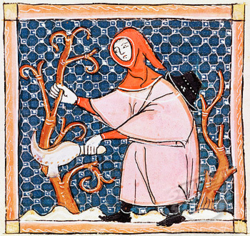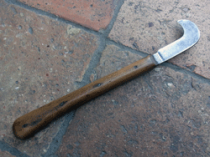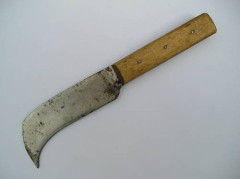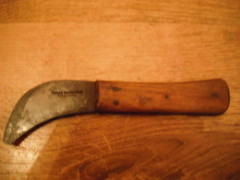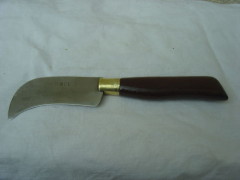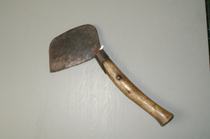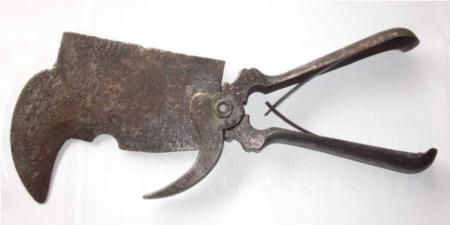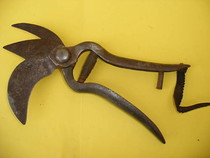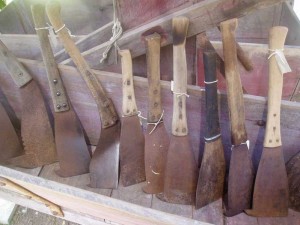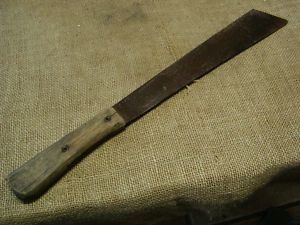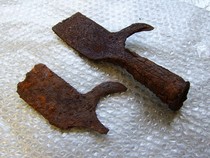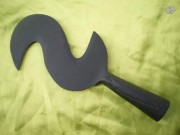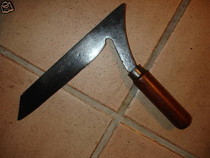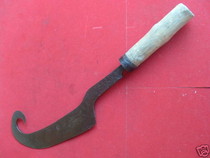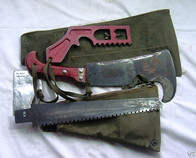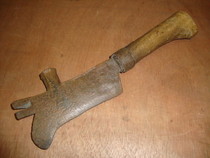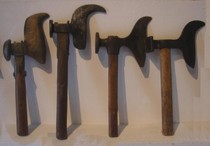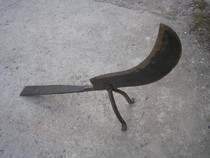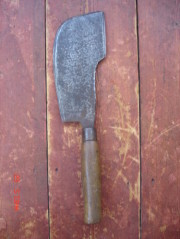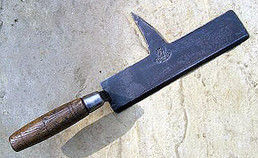Miscellaneous edge tools
This section is very much 'WORK IN PROGRESS' - I will update and add images to illustrate the tools...
Although billhook shaped, this is in fact a leatherworkers knife for cutting hides. Similar were also used for other sheet materials such as linoleum, rubber. The invention of the Stanley utilty knife has reduced use and thus the availabity of this type. To confuse matters, some manufacturers sold them as fixed blade pruning knives.
The following section has been pasted in from another document - it is slowly being updated and images added - it may duplicate some of the above information and that on the previous page (Not Billhooks)....
Spar Hook or Spit Hook: A small billhook, usually between 6” and 7” long, used by spar makers for the splitting
of hazel spars (or broches), used for securing the top layer of thatch to the undercoat. Occasionally spar makers used a hook sharpened on the outside edge. In France basket makers also split their willow or hazel using a wide variety of tools, including small billhooks (see above).
Block Hook: A billhook with a straight cutting edge, used for chopping onto a wooden block. The curved nose of a normal billhook would prevent the cutting edge making contact with the block. Used for splitting wood or trimming branches to the required length. Often with a hook, or spike on the back, to allow the user to pull the next piece within reach. The Knighton and Rodding patterns of English billhooks also had straight cutting edges, without the hooked nose, and many Dutch hooks and those from some parts of northern France and Belgium are similarly shaped.
Nobby Hook: A Dorset/Devon variation, similar in use to a block hook, but more like a square nosed bill hook, often made from a broken, or well worn, billhook. Sometimes known as a Trimming Hook, they are used by hurdle makers for cutting the protruding ends of hazel gads at the outer edges of the hurdle, by chopping against a piece of wood held in the other hand. Straight edged billhooks such as the Knighton or Rodding Patterns were used for similar purposes.
Gathering Hook: Not a cutting tool, but a hook used to gather the corn towards the harvester so it can be cut with the reap hook. Usually cut straight from the hedgerow, but sometimes a manufactured steel hook with a wooden handle. In some European countries a wooden finger-guard with a curved end is used.
Shearing Hook: Similar in appearance to a cranked bagging hook, but with a wider and slightly dished blade. It is a thatcher’s tool used on the backhand for levelling the surface of the thatch. It appears to be a left handed tool, but in use it used in the right hand, cutting from left to right, i.e. away from the thatcher and onto the finished section of roof.
Eaves Hook: A slightly curved hook, with a long blade, used by thatchers for trimming the under the eaves of a roof. Some counties, especially those that use combed water reed, not long straw, used the straighter eaves knife, which is fitted to a long handle.
Ridge Hook or Thatcher’s Knife: Usually a thin, straight, or convex, blade used to produce the decorative pattern to the lower edges of the ridge of
a thatched roof. Sometimes with a
cranked, or offset, handle to prevent the knuckles contacting the rough ends of the straw.
Trimming or Staff Hook: A light long handled usually socketed hook, with an open curved blade used for cutting back bushes and small regrowth on hedges.
Brush(ing) Hook: A medium duty trimming hook, used for cutting back denser undergrowth, overgrown hedges etc.
Slasher: A heavier and stronger version of the trimming hook, sometimes with a straight, or convex blade, used for cutting the thicker stems of large bushes etc. The blade is usually fixed to the handle with riveted straps, sometimes reinforced with a steel ring or with an elongated oval socket. French versions, known as Croissants, are often crescent-moon shaped with a wide blade – heavier than the English Staff hook
Bush Knife: In the USA, South Africa and Australia a long handled slasher, similar to a heavy billhook strapped to an axe handle, was used for cutting of heavy undergrowth.
Hooks:
Over the past 2000 years, a wide variety of billhook type tools have been made and used locally. As well as billhooks and pruning hooks, many makers produced a wide range of edge or cutting tools for use in agricultural, forestry, coppice work, horticulture, gardening, carpentry and building trades (and in continental Europe, various tools for use in vineyards):
Billhook*: Also known as a Bill, Hand-bill* or Hedging-bill - a medium duty curved hook with a blade length from 8” to 12” long, used for splitting and cutting of green wood up to about an inch and a half in diameter. It has been used in Britain and most other European countries for over 2000 years, and a wide range of regional patterns exist. It has been (and in some areas still is) used extensively for hedge laying, heavy pruning, hurdle making and many other coppice crafts. It is usually fitted with a caulked handle, but some patterns have a turned round or oval handle. Sometimes the blade is sharpened to a single bevel. The handle is most commonly fitted by a tang which passes through the handle, but some regional patterns have a socket for an inserted handle, or have wooden or leather scales riveted on.
*(Note: a Bill Hook is a wire hook widely used in offices and shops in Victorian times for holding completed papers such as paid bills, and a Hand Bill is a small printed leaflet or flyer).
Broom Hook: A double edged billhook, with a straight cutting edge to the rear of the curved blade. Often used by the makers of besom brooms to trim thebunch of birch twigs to the correct length, in a similar fashion to the block hook, more common in the Midlands and parts of Wales. The Yorkshire billhook is similar, but has a longer, strapped handle. In France and other European countries the double edge billhook is common, often with a long narrow back blade, and was widely used in the vineyards for pruning old vines (see below).
Pruning Hook: A small, light hook used primarily by gardeners and horticulturists for the pruning of plants with
a woody stem. Sometimes found with a shaft to the blade, similar to the gooseberry hook, or with a long extended handle. They were also made as a large pocket knife with a folding
blade.
Vineyard Hook: Common in most wine producing countries, usually with a (long and often narrow) back blade used until the mid 19th century for pruning grape vines (usually in February or March). Widely replaced by the secateurs in most vineyards, it remained in use until the late 20th century in some regions of France, and some versions are still made (and presumably used) in Italy at the beginning of the 21st . It probably existed in England in medieval times, but disappeared when wine growing ceased.
Grape Hook: No real equivalent in England – a very small hook commonly used in France, and also other European
wine growing countries, for cutting the bunches of grapes from the vine during the vendange or wine harvest. From the mid 19th century it was also superseded
by the secateurs. It is often very similar to, and mistaken for, the basket maker’s hook (below).
Gentleman’s Hook: Also a smaller Lady’s Hook - a small billhook, often double edged, usually with a polished blade, brass ferrule and ornate hardwood handle. Often made by makers who did not normally supply forestry or agricultural tools, but who did supply gardening tools. The London firm of Holtzapfel, makers of engineering tools and ornamental lathes, also made them for their customers.
Milton Hatchet: A version of a double edged gentleman’s’ hook, usually with a handle made with riveted horn or bone scales. The blade is much thicker than usual, and the rear blade is also unusual in that it only has a single bevel, similar to a carpenter’s chisel. Origins unknown, but appears in the Sheffield List and the author has one made by Stothert of Bath (late 18th or early 19th century as by 1815 they were established as foundry-men and engineers).
This section to be rewritten and further images added - text below is a draft
Hop Hook: For cutting the strings that held hops to the hop poles long handled hooks were used, consisting of a socketed or tanged blade similar to a small reap hook that was attached to a pole some 10 to 12 feet long. Often these also had a small hook projecting from the back of the blade that could be used in lowering the hop bine to the ground, or possibly also in the fixing of the network of that went from ground level to the tops of the poles for the hops to grow up.
Secateurs & Serpo-secateurs: The invention of the secateur in by Bertrand de Moleville (a former Minister to Louis XVI exiled from in France after the Revolution, and who, prior to the return of the Boubons in 1815, occupied his spare time in invention) and promoted by Pierre Antoine Poiteau (botanist, head gardener at Montainbleau from 1822 and from 1829 to 1851 director of the Revue Horticole) led to the gradual decline of the pruning hook, particularly in France*, where it had been widely used for trimming grape vines (La Taille). For a while hybrid tools, the Serpe-Secateur (also known as a serpo-secateur)or the smaller Serpette-Secateur, were manufactured – a pair of secateurs having a small billhook blade (sometimes an axe blade, or both axe and billhook, or even a small sickle) projecting from the rear of one or both cutting blades. Some versions were like a billhook with a secondary secateur blade added.
* Secateurs were at first not widely used in vineyards, and in his 1887 publication ‘Eléments d'Arboriculture Fruitière’ Louis HENRY decried their use, stating that they damaged the shoots and led to disease. However by1898 Paul COSTE-FLORET in his work ‘Les Travaux du Vignoble’, confirmed that in the Mediterranean regions (from Languedoc-Roussillon in the west to Provence in the east) they were widely used as they were quicker and safer to use: « La Taille est exécutée par des hommes expérimentés se servant du sécateur, plus expéditif, plus commode et moins dangereux que l'ancienne serpe aujourd'hui complètement abandonnée ».
The secateur seems to have been more readily accepted in England, thanks mainly to William Robinson, a Victorian gardener and writer, a contemporary of Gertude Jeykll.
Machete or Cutlass: For colonial use a lightweight tool with a thin, broad blade was developed, ideal for cutting overhanging vegetation and able to be used for long periods at a time without fatigue (e.g. cutting trails through dense undergrowth). These were made in a wide range of shapes and sizes, some of which have hooked end similar to an elongated billhook. These are sometimes similar in shape to the falx, a large curved sword used by the people from Dalmatia (one of the few weapons to strike fear into the heart of a roman soldier as its curved point was able to penetrate through the roman shield wall). Today many forms of machete and jungle knife are manufactured for export and also for military usage; however, many countries (e.g. Brazil, Columbia or South Africa) now have their own edge tool manufacturers and are no longer reliant upon imports from Europe.
Cane Knife:
For cutting sugar cane a wide variety of knives and hooks are used, some similar in style to the machete with thin flexible blades, and others very similar in shape to billhooks. Like the machete, these were made in large numbers and exported to the colonies.
Pruning Chisel:
For removing branches from trees that could not be easily reached, a wide variety of tools were made to be fitted to a long handle. Some were similar to a large socketed chisel that cut in an upwards direction, with a billhook blade on the side that cut on the pull stroke, and others were S shaped, with blades that cut in either direction (see Coup-gui, below).
Coup-Gui: also known as an emondoir or an echellinoir, this is often similar to a small curved billhook mounted on a long handle and is used in France for removing the parasitic growth of mistletoe from fruit trees. Not found in the UK, although the pruning chisel type (see above and below) is found in both countries.
Coup-marc: used for cutting up the marc or residue from wine or cider presses, it usually has a long handle and may be similar to a slasher in shape. Sometimes an old blade is remounted in a shorter handle and used for other purposes, such as cutting up smaller pieces of the marc or for chopping kindling wood. Many different patterns exist, some axe shaped and like a small hayknife. It was known in the cider regions of England, e.g. Somerset or Herefordshire, but is rare and not commonly recognised as such.
Banana Knife: A small hooked knife used for cutting bunches of bananas from the plant. Also used in the banana ripening factories in the UK such as that run by Geest in Warminster (Wiltshire) from 1958 until it closed in the 1980's. For more images visit banana.org
Woodsman’s Pal: For some reason the billhook never became popular in the USA, although several manufacturers did offer them. However a combination tool (billhook, digging tool and machete), designated the LC-14-B, designed by Frederick Ehrsam (a Swiss émigré) in 1941 and manufactured by the Victor Tool Co. of Reading, PA, became the standard issue to US Marine Corps. During the Vietnam War it was known as a Type IV Survival Axe, the main component of the "Tool Kit, Survival, Type IV" issued as NSN8465-973-4807 under specification IL-S-8642C, and was manufactured by Frank & Warren, Inc. It is still made in several variations of size and type of handle by Pro Tool Industries of Boyertown, PA.. Un-licensed copies are now being made in India and Pakistan, but are usually of poor quality
Sheaf
Knife: A small curved knife use by thrashers to removes the binding of the sheaf before feeding it
into the
thrashing machine. Often found with a hole in the handle for a loop of string to go around the wrist so that it would not drop into the machine when the sheaf was being separated. US
makers produced a leather glove with a cutting blade attached.
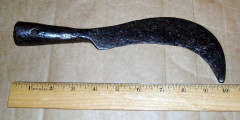 One of the few US fascine knives with genuine provenance - c 1777 Fort Montgomery, Orance County, New York
One of the few US fascine knives with genuine provenance - c 1777 Fort Montgomery, Orance County, New York
Fascine Knife: Although the billhook was not widely used in the USA, one type often known as a fascine knife was used by the military for creating fascines and gabions out of brushwood (hurdle like structures), used to support earth embankments in dug-in gun (cannon) positions. Later they were more widely used for machine gun emplacements, and in the French and UK armies ‘pattern’ billhooks were issued as a tool to machine gun units in WWl and to Pioneer Corps.
Combination hooks: Several makers offered a combination of billhook and hammer, with and without nail puller, and some French makers offered a combined billhook and letter punch for timber marking in place of the more usual tool that combined the punch with an axe blade. A combined billhook and large hammer head for driving in stakes for use in french vineyards is also sometimes seen.
Miscellaneous Tools: A wide range of other chopping and cutting tools can be found for
harvesting a variety of crops, these include Beet Knives, used for topping and tailing of sugar beet and other varieties
or mangolds or turnips grown as feed for livestock and Cabbage Knives, for cutting the thick woody stems of cabbages and
sprouts; Lettuce Knives for trimming lettuces; Cotton knives (USA) or just general pattern Field Knives. In France the ‘serpe à betterave’ is a billhook
shapedbeet knife with a thin blade. English
beet knives often have a spike on the back (similar to a block hook), or sometimes on the front of the blade, used for picking the next beet from the pile… In India a billhook
shaped tool with a tripod leg arrangement, used cutting edge
uppermost, is used for removing the husk from coconuts and for the preparation of vegetables for cooking.
Other Hooks: Some other trades use hooked tools, similar in appearance to small billhooks for the cutting of soft sheet materials. Plumbers and glaziers use them for cutting lead or zinc sheet; saddlers and shoemakers used them for cutting leather; electricians for removing the insulation from cables; and they have been made for cutting flooring materials, such as linoleum. Often of a good quality, they are sometimes mistaken for pruning hooks, although it is possible manufacturers sold the same tool to different wholesalers for different uses………
Choppers and Cleavers: Many meat cleavers and choppers share similarities with billhooks, and vary only in the blade profile. In some countries there is no distinction between the word for a wood-cutting tool and that for a meat cleaver, and in poorer households the same tool was probably used for both tasks. In the UK many distinct regional patterns of meat cleavers can be found. Many billhook makers also made meat cleavers and choppers, although some makers specialised just in butcher's tools.
Slater’s axe, or Zax (Saz or Sax??) Used for cutting slates to size, commonly found with an offset blade and a point on the back to punch the nail hole, they closely resemble a square edged billhook. Longer and narrower versions without the spike were used in the quarries of Cumbria.
Diderot’s Encyclopaedia shows billhook type tools being used in 18th century french glassworks. In France tools that look like billhooks were used in ostriculture, to harvest the oysters, but although the back blade is sharpened like that on a double edged billhook, the main hook is blunt. Smaller oyster knives were used to open the shells.
Other Tools: Most other edge tools fall outside the subject matter of this site, but almost all other trades used some form of edge tool. As well as those previously mentioned, edge tool makers would supply blades for chaff and root vegetable cutters (often worn blades would be converted to billhooks or beet knives by riveting onto a tang); block knives as used by clog makers; trowels and chisels for masons and bricklayers; riving and cleaving tools such as froes used by chair makers, coopers and others. Larger makers such as Fussell of Mells showed a wide range of tools of all types in their pattern books, that do not appear in their commercial catalogue, and would also make tools to special order either as one-offs, small batches or as agents for a patent holder (Talabot in France offered the same service in their 1935 catalogue).
